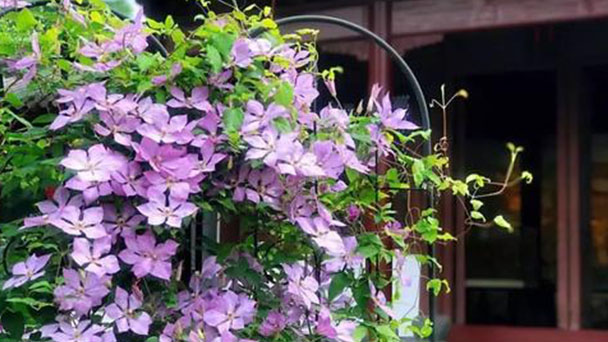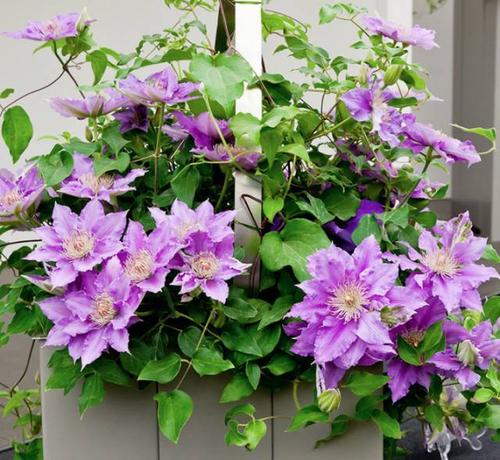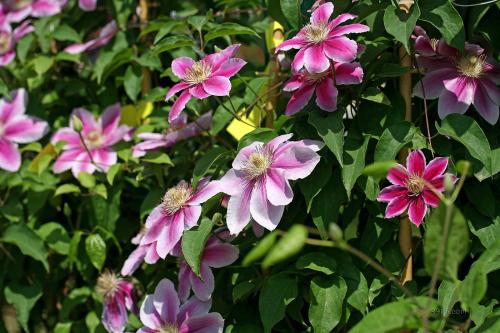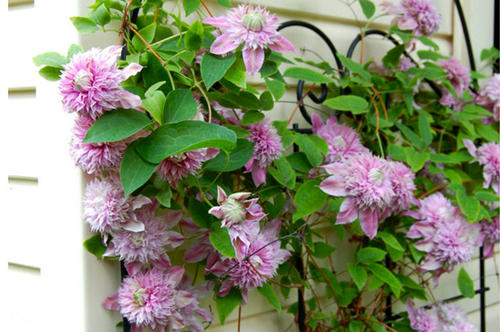Asian Virginsbower (Clematis Florida) Profile: Plant Facts & Care Guide
Written by Maggie
Dec 27 2021

Asian virginsbower, scientific name Clematis florida, is a deciduous or evergreen vine, flowers from early spring to late autumn (with a few winter flowering varieties), fruit in summer, can be cultivated for ornamental garden.
Asian Virginsbower Picture

Asian Virginsbower Info
| Botanical Name | Clematis florida |
| Common Names | Asian virginsbower |
| Plant Type | Blooming plant |
| Mature Size | Climbs to 20 feet (6 meters) high |
| Water Req | Moist soil |
| Bloom time | Late summer or early fall |
| Sun | Full sun to shade |
| Flower color | Pure white |
Characteristics of Asian Virginsbower
Leaf of Asian Virginsbower
Asian virginsbower is a grassy vine, about 1 to 2 meters long. Stems are brown or purplish red, with six longitudinal lines, nodes swollen, sparsely pubescent.2 to 3 compound leaves, even petiole up to 12 cm; Leaf blade is narrowly ovate to lanceolate, 2 -- 6 cm long, 1 -- 2 cm wide, apically obtuse, base rounded or broadly cuneate, margin entire, very rarely divided, neither covered with hair, veins inconspicuous; Petiole is clearly visible, short or 1 cm long;Petiole 4 cm long.
Flower of Asian Virginsbower
Flowers are solitary in leaf axils of Asian virginsbower; Pedicels are ca. 6 -- 11 cm, nearly glabrous, with a pair of leaflike bracts in the lower middle part; Bracts are broadly ovoid or ovoid triangular, 2 -- 3 cm long, base sessile or shortly stipitate, yellow pilose; Flowers are spreading, ca. 5 cm in diam. Asian virginsbower has 6 sepals, white, obovate or spatulate, 3 cm long and 1.5 cm wide, apex more acute, base tapered, inner surface glabrous, outside forming a linear-lanceolate band along three straight mid veins, densely tomentose, margin glabrous; Stamens are purplish red, filaments broadly linear, glabrous, anthers lateral, oblong, rounded, shorter than filaments; Ovary is narrowly ovate, pale yellow pilose, style short, distally glabrous, stigma swollen into a head, micro2-lobed. (Find more Climbing Plants with Flowers here.)
Fruit of Asian Virginsbower
Achenes are obovate, flattened, margin thickened, persistent styles elongated into beaks, thin, with spreading pubescent below, glabrous above, and expanded stigma 2-lobed.
The flowering period of asian virginsbower is from January to February, and the fruiting period is from March to April
Asian Virginsbower Habits
Asian virginsbower grows on the hilly thickets of the low mountains. It prefers fertile, well-drained alkaline loam, avoids water or summer drought and can not hold water soil. Asian virginsbower has strong cold resistance, and can withstand -20 low temperature. There are red spider or leaf-eating pests and need to strengthen ventilation.

Asian Virginsbower Distribution
Asian virginsbower (Clematis florida) is distributed in Guangxi, Guangdong, Hunan, Jiangxi. Born in low mountain hills in thickets, valleys, roadside and streams. It is cultivated in Japan.
How to Grow & Care for Asian Virginsbower
The stems of Asian virginsbower should be cut to a height of 30cm before planting to facilitate their branching and avoid stem breakage during planting. The stem base of Asian virginsbower should be 3~5cm below the soil surface. The plants should be placed at a suitable depth, covered with soil, compressed, and watered. Asian virginsbower roots like a cool environment. Covering 3~5cm thick mulch (such as bark, moss, etc.) on the planting substrate can provide a good and cool root environment, which is conducive to the growth of plant roots. Planting time is arranged in spring or autumn.
Read More:
How to Grow & Care for Asian Virginsbower
How to Care for Asian Virginsbower Leaves Black Spots & New Buds Wilting
How to Propagate Asian Virginsbower
Asian Virginsbower can be propagated by sowing, layering, grafting, splitting or cutting propagation.
Sowing
The Asian Virginsbower can be propagated by sowing. Cotyledon unearthed type seeds (achenes smaller, thin pericarp), if sown in spring, about 3 to 4 weeks can bud. Sow in the autumn and germinate when the spring is warm. Seeds of cotyledon type (larger with thicker seed coat) can only germinate after a low temperature vernalization stage, and the first pair of true leaves are born. Some species of Asian Virginsbower (Clematis florida) need to go through two low temperature stages before they can germinate, such as the trochanteric lotus. If the seeds were refrigerated at 0~3℃ for 40 days, it would take about 9~10 months to germinate.It can also be treated with a certain concentration of gibberellin.
Layering
In spring, the last year's mature branches of Asian Virginsbower are pressed. Roots usually take root within a year.
Division
Asian Virginsbower can be divided into plants.
Cuttings
The main propagation method of hybrid Asian Virginsbower cultivars is cutting. Semi-mature branches were taken in summer and internodes (i.e., the middle of the upper and lower sections) were internodes with 2 buds. The medium is half peat and half sand. Cuttage depth for the section on the bud just exposed above. The bottom temperature 15 ~ 18 ℃. After taking root, put it in a 3 inch pot and overwinter in an antifreeze hotbed or greenhouse. In spring, change 4 to 5 inch pots and move them out of the room. Summer to shade against showers, planting at the end of autumn.
Read More: How to Propagate Asian Virginsbower (5 Ways)
Asian Virginsbower Uses
Asian Virginsbower (Clematis florida) can be used as exhibition cut flowers, can be used to climb evergreen or deciduous tree shrubs, can be used as ground cover; Roots and whole grass are used as a medicine, blood circulation and pain relief. It is used for urination, abdominal distension and stool closure. Asian virginsbower has external use for joint swelling and pain, insect and snake bite.

Read Next:
Top 20 Climbing Plants with Flowers for Your Garden
Latest Updated
- Benefits of Bugleweed - 7 Science-backed Health Benefits
- Bugleweed Dangers & Side Effects - Is It Poisonous?
- How to Plant Evergreen Trees - What You Should Know
- When to Plant Evergreens - Grow Guide for Evergreen Trees
- 12 Wonderful Evergreen Shrubs for Your Garden
- 12 Popular Evergreen Plants with Pictures for Beginners
- When And How To Prune A Lilac Bush Like a Pro
- How to Grow & Care for Lilac Vine (Hardenbergia Violacea)
- Japanese Lilac Tree (Syringa Reticulata) Care & Propagation Guide
- Shumard Oak Pros and Cons - What to Know
Popular Articles
- Winter maintenance of Antirrhinum Majus
- How to Grow Terminalia Mantaly Tree
- How to Grow and Care for Crossostephium Chinense
- How to grow Antirrhinum Majus in spring
- Peristeria Elata (Dove Orchid) Profile: Info & Care Guide
- Underwatered Snake Plant (Sansevieria Trifasciata) - Signs And How To Fix
- How to Care for Brazilian Jasmine Plant (Mandevilla Sanderi)
- How to Grow & Care for Graptopetalum Purple Delight in Summer
- Rosa Chinensis (China Rose): Plant Growing & Care Tips
- How to Care for Baby Sun Rose (Aptenia Cordifolia)